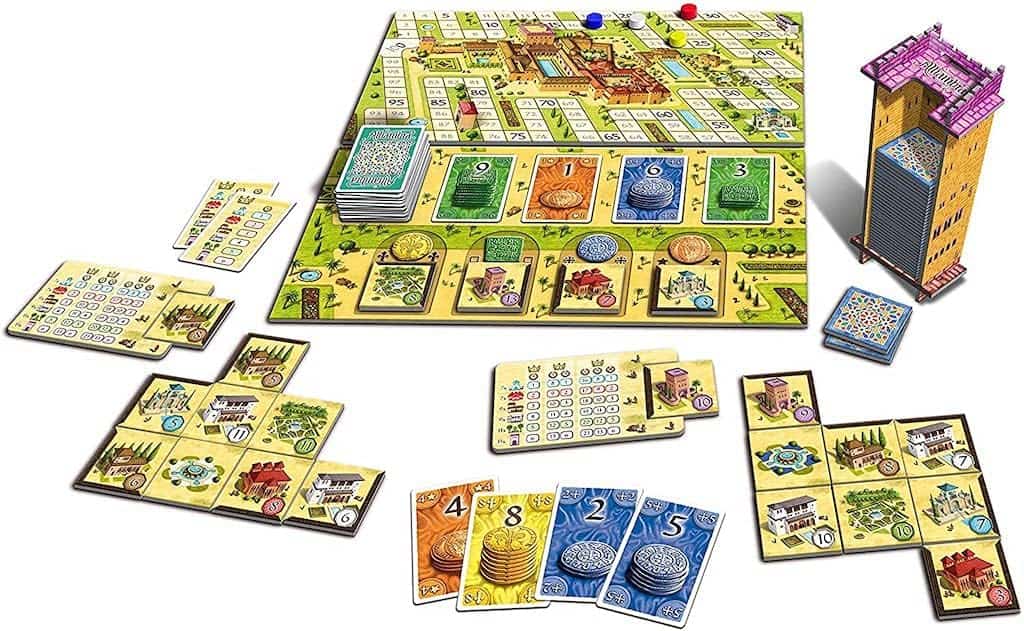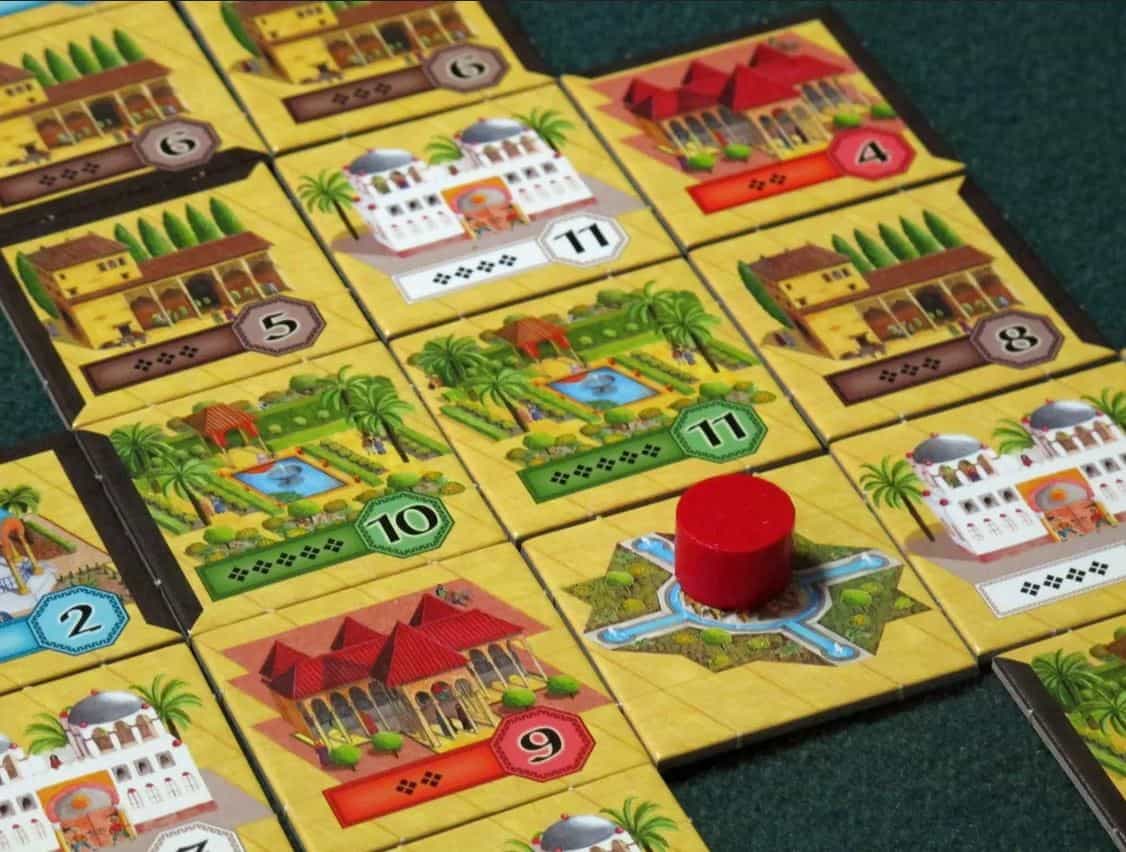Alhambra is a board game that transports players to a world of architectural splendor and intricate design. Set in the exotic backdrop of Moorish Spain, it invites players to become master builders of their own Alhambra, the iconic palace complex of Granada.
The game’s aesthetic beauty echoes the real-life Alhambra’s exquisite blend of Islamic artistry and lush gardens. Each turn is a work of art as players carefully select and place tiles representing ornate archways, vibrant tiles, and serene gardens to construct their palace.
Amidst this visual feast, players employ strategic prowess to craft their Alhambra to perfection, creating a captivating tapestry of design and function. “Alhambra” is a masterpiece that marries aesthetics with strategy, inviting players to embark on a journey of artistic creation within the confines of a board game, where each move unfolds like a stroke of the brush on a canvas.
What’s included in Alhambra

- Game board: The board has a scoring track, currency exchange rates, and spaces for building tiles.
- Building tiles: These come in various colors (yellow, blue, green, and orange) and values. Some tiles also feature walls, fountains, and gardens.
- Currency cards: These represent different denominations of money (coins).
- Building market: A display of four face-up building tiles that players can purchase.
- Scoring tokens: Each player has tokens in four colors for scoring.
- Starting player marker.
- Bag for currency cards.
How to play Alhambra
Setup
- Place the game board in the center of the table.
- Shuffle the currency cards and create a draw pile.
- Lay out the building market with four face-up tiles.
- Each player takes one scoring token of each color and places them on the “0” space of the scoring track.
- Randomly determine the starting player.
Rules for Alhambra

The game is played over several rounds, each consisting of the following phases:
1. Buy Buildings Phase: Starting with the first player and proceeding clockwise, players take turns performing one of the following actions:
- Take currency cards: Draw the top face-down card from the draw pile or take all the face-up cards of one currency color.
- Purchase a building tile: Pay the cost in currency cards and take a building tile from the market, placing it in your reserve.
2. Place Buildings Phase: During this phase, you may do one of the following actions:
- Place a building tile: Pay the cost in currency cards and place a tile from your reserve onto your Alhambra. Tiles must be placed adjacent to each other and must match colors.
- Swap and place: Pay the cost in currency cards, remove a tile from your Alhambra, and replace it with a new one from your reserve.
3. Score Points Phase: After placing tiles, players may score points based on the following elements in their Alhambra:
- Fountains: Each fountain tile scores 1 point for each adjacent tile (horizontally and vertically).
- Gardens: Each garden tile scores points for the longest continuous chain of garden tiles.
- Walls: Each wall tile scores points based on the longest adjacent wall.
- Buildings: Some building tiles have endgame scoring conditions, which are applied during this phase.
4. Prepare for the Next Round: Refill the building market with tiles from the bag and advance the starting player marker clockwise.
Scoring:
- Players score points for having the most and second-most of each building type at the end of each round (except for the first round).
- Scoring cards indicate the points awarded for each building type.
Winning the Game:
In Alhambra, the game ends after the completion of the third and fourth rounds, depending on the number of players. Here’s how to determine the end of the game:
- Three Players: The game ends after the completion of the third round.
- Four Players: The game ends after the completion of the fourth round.
To complete a round, you continue playing until the round marker has made a full circuit around the game board and returns to the starting space. At this point, the current round ends, and you proceed to scoring.
Scoring at the End of the Game: After the final round, you calculate the final scores to determine the winner. Here’s how scoring works:
- Building Scoring Cards: Players receive points for having the most and second-most of each building type, as indicated on the scoring cards. Only the player with the most and second-most of a building type in their palace scores points for that type. Ties for the most or second-most are both awarded points.
- Currency Cards: Players score points based on the value of their remaining currency cards. Each currency card has a numerical value, and these values are summed up.
- Remaining Building Tiles: Players score points for each building tile left in their reserve area. The value of each tile is indicated in the lower right corner.
- Longest Outer Wall: If there is a tie in points after the above calculations, the player with the longest unbroken outer wall in their palace wins. The outer wall is the continuous line of tiles that encloses the palace area.
- Different Building Types: If there is still a tie, the player with the most different types of buildings in their palace wins.
The player with the highest total points wins the game. In case of a tie after all tiebreakers, the game is a draw, and the tied players share the victory.
For the official rules, see the link below:
How to win Alhambra
- Color Diversity: Try to diversify your Alhambra’s colors early on. Having a good mix of colors will increase your flexibility when placing tiles and maximize your opportunities for scoring points.
- Focus on Gardens: Gardens can be a significant source of points. Aim to create long chains of garden tiles, as the longer the chain, the more points you’ll score. Be mindful of your opponents’ garden chains too, as it might be worth interrupting them to prevent them from scoring big.
- Acquire High-Value Tiles: Pay attention to the values of the tiles available in the market. High-value tiles can be worth a lot of points, so try to acquire them when they become available.
- Adapt to Scoring Opportunities: Keep an eye on the scoring opportunities in the game. For example, if you notice a lot of wall tiles appearing in the market, consider adjusting your strategy to focus on walls and score points accordingly.
- Manage Your Currency: Efficiently managing your currency is essential. Collecting the right amount and types of currency cards is crucial to ensure you can purchase the tiles you need when they become available.
- Balanced Layout: Try to maintain a balanced layout in your Alhambra. Having a good mix of different building types (like walls, fountains, and buildings) can help you score points from various sources.
- Currency Exchange: Pay attention to the exchange rates on the game board. Converting excess currency into valuable coins can be a smart move, especially when you need to make critical purchases.
- Plan Ahead: Think about the future as you place tiles. Consider the tiles that might come up in the market, and try to leave space for them in your Alhambra. Planning ahead can help you maximize your points in later rounds.
- Interact with Opponents: Be aware of what your opponents are doing. Try to anticipate their tile choices and interrupt their plans when it makes sense. This interaction adds depth to the strategy.
- Flexibility: Stay flexible and be willing to adapt your strategy based on the tiles available and the evolving game state. Sometimes it’s better to change your focus than to stick to a rigid plan.
- Scoring Tiles: Pay attention to the scoring tiles that come up in the game. These can significantly impact the final scoring, so consider acquiring tiles that match the scoring tiles to maximize your points.